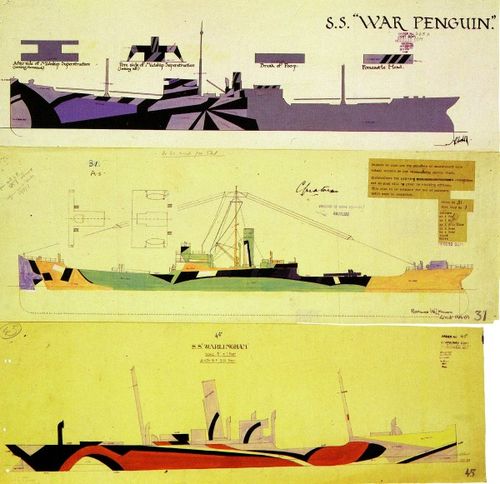JF Ptak Science Books (Fixing an earlier post from 2011) Part of a series on the History of Blank, Empty and Missing Things.
In the history of defensive warfare it was a revolutionary idea that painting the entirety of large ocean-going ship in sharp geometric shapes and in dazzling colors would make the ship in essence--disappear, a sort of camouflage-without -camouflage (sorry Flannery O'Connor). It wasn't like biological camouflage where all sorts of bits come into play to make an animal blend into its surrounding environment to protect it from predators, or conversely to make it a better predator by allowing the animal to stay completely hidden until their prey could do nothing but become their prize. Nor was it really like thermoregulation, or sexual or warning signals (again drawing from the bio world)--it was simpler than that, though are there many relational examples in the biological world as well. Nor was it similar to the camouflage schemes used by the air corps, with different and usually sky/ground-blended colors used for the top and bottom of SPADS and Nieuports and Albatrosses.
The effect of using the geometrical shapes on the whole of a 600'-long vessel was to make the speed and direction of the ship more difficult for offensive pursuit vessels like submarines to figure out and calculate so that the point-to-target launch of their torpedo would be far more complicated.
[Examples of razzle dazzle camouflage from the GoTouring website, here.] [A very nice selection of images can also be found at iO9.com, here; also, an even larger one, here, from Public Domain Review]
When the prolific maritime painter Norman Wilkinson (1878-1971) came to this realization for disguising the intentions of ships (around 1917) he instantly recognized its applicability in anti-submarine warfare: not only would it be difficult to distinguish bow/stern properties of a ship, but also how long it was, and whether it was coming or going, and how big it was--all major factors in determining the launch of a torpedo. Basically, dazzle camouflage made it difficult to produce a trajectory for the ship.
This must have been an extraordinary experience, seeing these things for the first time by military commanders, who not but a few years earlier were sending troops into combat with white gloves and red pantaloons.

[ Another example of razzle dazzle at work: RMS Empress of Russia, from the University of British Columbia, here]
 [Image source: Wikipedia, here.]
[Image source: Wikipedia, here.]
Edward Wadsworth (1889-1949) produced razzle dazzle designs during the war and also painted about it afterwards--something one really doesn't see much of--in his fine Painting of Dazzle-ships in Drydock, completed in 1919. (More of Wadsworth's works, as prints, here.) There are well-known stories of great artists--like Villard among many others as well as the questionable Picasso, who claims to have originated the idea, along with Cubism itself--who made contributions in this effort, from making designs to doing the actual painting. But it was the estimable Wilkinson who made the major contribution and invention of dazzle-at-sea.
The concept is still used, with more advanced applications, and appears on one of the world's stealthiest ships, Sweden's Visby Corvette. Apart from having an exceptionally low magnetic signature, it also has geometric low-radar reflective gray dazzle paint. (It also has applications for land warfare use in the camouflage of armored vehicles against RPGs.).



Comments